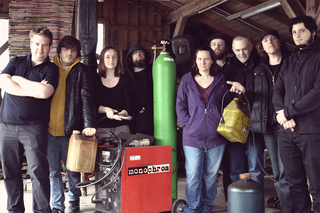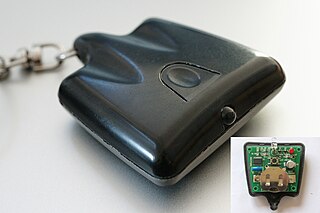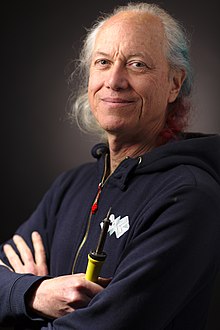
"Do it yourself" ("DIY") is the method of building, modifying, or repairing things by oneself without the direct aid of professionals or certified experts. Academic research has described DIY as behaviors where "individuals use raw and semi-raw materials and parts to produce, transform, or reconstruct material possessions, including those drawn from the natural environment ". DIY behavior can be triggered by various motivations previously categorized as marketplace motivations, and identity enhancement.

Jaron Zepel Lanier is an American computer scientist, visual artist, computer philosophy writer, technologist, futurist, and composer of contemporary classical music. Considered a founder of the field of virtual reality, Lanier and Thomas G. Zimmerman left Atari in 1985 to found VPL Research, Inc., the first company to sell VR goggles and wired gloves. In the late 1990s, Lanier worked on applications for Internet2, and in the 2000s, he was a visiting scholar at Silicon Graphics and various universities. In 2006 he began to work at Microsoft, and from 2009 has worked at Microsoft Research as an Interdisciplinary Scientist.

Monochrom is an international art-technology-philosophy group, publishing house and film production company. It was founded in 1993, and defines itself as "an unpeculiar mixture of proto-aesthetic fringe work, pop attitude, subcultural science and political activism". Its main office is located at Museumsquartier/Vienna.

A fab lab is a small-scale workshop offering (personal) digital fabrication.

TV-B-Gone is a universal remote control device for turning off various brands of television sets. Released in 2004, its inventor referred to it as "an environmental management device". Although it can require up to 72 seconds for the device to find the proper code for a particular television receiver, the most popular televisions turn off in the first few seconds.
WPGU is a fully commercial, student-run college radio station on the campus of the University of Illinois Urbana-Champaign in Champaign, Illinois. It broadcasts an alternative rock radio format and other programming throughout Champaign-Urbana and surrounding communities. It is owned independently from the university by the Illini Media Company.
Make is an American magazine published since February 2005 which focuses on Do It Yourself (DIY) and/or Do It With Others (DIWO) projects involving computers, electronics, metalworking, robotics, woodworking and other disciplines. The magazine is marketed to people who enjoyed making things and features complex projects which can often be completed with cheap materials, including household items. Make is considered "a central organ of the maker movement".
White Dot is an anti-television organisation based in the UK. It encourages people to not watch television, and also to switch off televisions in cafés and pubs with devices such as the TV-B-Gone. It also organises what it calls zocalo events where people are requested to turn off their televisions, go outside and talk to their neighbours.

The College of Media is a college at the University of Illinois Urbana-Champaign, United States. The college's name changed from the College of Communications to the College of Media in 2008.
Body hacking is the application of the hacker ethic in pursuit of enhancement or change to the body's functions through technological means, such as do-it-yourself cybernetic devices or by introducing biochemicals.

A hackerspace is a community-operated, often "not for profit", workspace where people with common interests, such as computers, machining, technology, science, digital art, or electronic art, can meet, socialize, and collaborate. Hackerspaces are comparable to other community-operated spaces with similar aims and mechanisms such as Fab Lab, men's sheds, and commercial "for-profit" companies.
TOG is a hackerspace in Dublin, Ireland. tóg is a word in the Irish language; one of its meanings is 'to build or construct'.

The maker culture is a contemporary subculture representing a technology-based extension of DIY culture that intersects with hardware-oriented parts of hacker culture and revels in the creation of new devices as well as tinkering with existing ones. The maker culture in general supports open-source hardware. Typical interests enjoyed by the maker culture include engineering-oriented pursuits such as electronics, robotics, 3-D printing, and the use of computer numeric control tools, as well as more traditional activities such as metalworking, woodworking, and, mainly, its predecessor, traditional arts and crafts.

Limor Fried is an American electrical engineer and owner of the electronics hobbyist company Adafruit Industries. She is influential in the open-source hardware community, having participated in the first Open Source Hardware Summit and the drafting of the Open Source Hardware definition, and is known by her moniker ladyada, an homage to Lady Ada Lovelace.

John Bohannon is an American science journalist and scientist who is Director of Science at Primer, an artificial intelligence company headquartered in San Francisco, California. He is known for his career prior to Primer as a science journalist and Harvard University biologist, most notably with his "Gonzo Scientist" online series at Science Magazine and his creation of the annual "Dance Your PhD" contest. His investigative journalism work includes:
Text to speech in digital television refers to digital television products that use speech synthesis to enable access to blind or partially sighted people. By combining a digital television with a speech synthesis engine, blind and partially sighted people are able to access information that is normally displayed visually in order to operate the menus and electronic program guides of the receiver.
VPL Research was one of the first companies that developed and sold virtual reality products. It was founded by computer scientist Jaron Lanier in 1984. "VPL" stood for "Virtual Programming Languages". In 1990, VPL Research filed for bankruptcy and in 1999 all of its patents were bought by Sun Microsystems.

A library makerspace, also named Hackerspace or Hacklab, is an area and/or service that offers library patrons an opportunity to create intellectual and physical materials using resources such as computers, 3-D printers, audio and video capture and editing tools, and traditional arts and crafts supplies. In the field of library science, makerspaces are classified as a type of library service offered by librarians to patrons.
Maker education closely associated with STEM learning, is an approach to problem-based and project-based learning that relies upon hands-on, often collaborative, learning experiences as a method for solving authentic problems. People who participate in making often call themselves "makers" of the maker movement and develop their projects in makerspaces, or development studios which emphasize prototyping and the repurposing of found objects in service of creating new inventions or innovations. Culturally, makerspaces, both inside and outside of schools, are associated with collaboration and the free flow of ideas. In schools, maker education stresses the importance of learner-driven experience, interdisciplinary learning, peer-to-peer teaching, iteration, and the notion of "failing forward", or the idea that mistake-based learning is crucial to the learning process and eventual success of a project.
Hacking at Leaves is a 2024 Austrian documentary film directed and written by Johannes Grenzfurthner. It explores various themes including the United States' colonial past, Navajo tribal history, and the hacker movement, through the lens of the story of a hackerspace in Durango, Colorado, during the early phase of the COVID-19 pandemic. The film was produced by monochrom.












